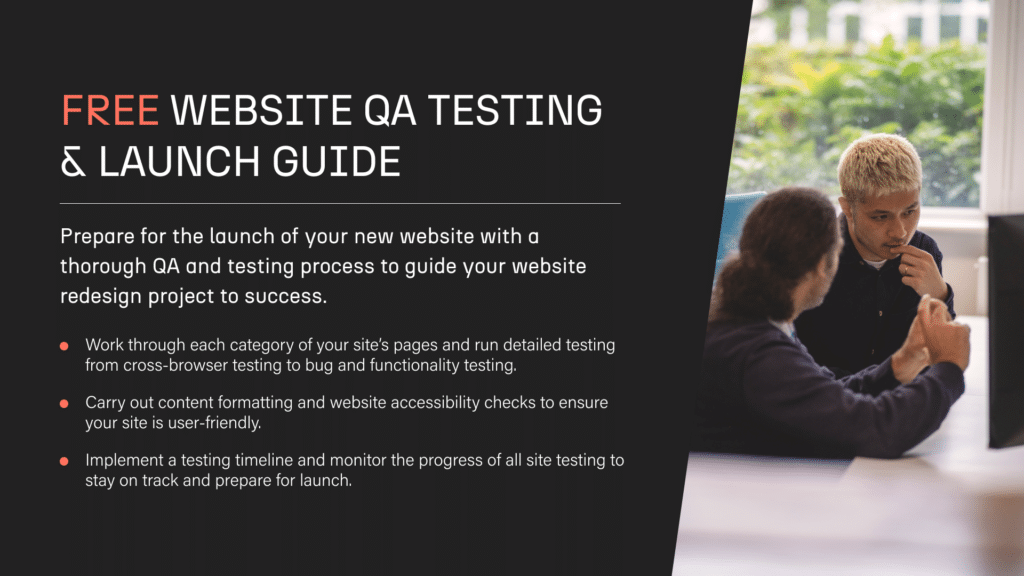Website QA Testing & Launch Guide [with Checklist]
After months of work, you’ll be chomping at the bit to show off your new site to customers, competition and pretty much the rest of the internet. But before you do that, there’s the not-so-small matter of testing the whole thing first.
Without website QA testing, the project you’ve poured all that time, effort and vision into, will likely be a broken, buggy mess. And that won’t just be frustrating for you and everyone else who worked on it, it could also be catastrophic from a commercial point of view. It’s a simple truth: a site that doesn’t work will struggle to convert.
A wonky website can wreak havoc on your brand identity, revenue and leads. That’s why the fine-tooth comb of quality assurance is absolutely vital. Here, we’ll go through why website QA testing matters, the website test steps you should carry out, and what you can do to maintain the quality of your site after a website launch.
Quick Navigation
- Testing your new website before launch
- Carrying out QA: What to test your website for
- The website launch stage
- Website maintenance
Testing your new website before launch
Why website QA testing is important
Put simply, because it makes sure your website works as you intended it to. QA stops errors and issues from slipping through the cracks, the same issues and errors which affect the user experience, and have users clicking the back button in the blink of an eye.
An issue-free website can benefit you in a number of different ways, too. In the eyes of consumers, a quality site means a quality brand – one that they’ll be happy to purchase your products and services through. The association is a powerful one, which means the link between a poor site and a brand is a hard one to reverse – even if you’ve corrected the issues later down the line.
It can also save you a packet too. Fixing bugs after a site has gone live is a major money (and time) sink. Since no one will be affected, you won’t lose traffic and business, two things that will more than likely happen if you have to shut down the site while the fixes are remedied.
The consequences of launching a website without testing
Surely a few errors here and there are forgivable right? Unfortunately, web users aren’t quite so merciful! Even the smallest fault has the power to truly ruin the experience for customers, and there are all sorts of stats out there which can back that up.
Webflow support company Sweor dug up the dirt on the effects of poor web design and found the following:
- 57% of internet users said they wouldn’t recommend a business with a poorly designed website on mobile
- 38% of people will stop engaging with a website if they don’t like the content or layout
- 88% of online consumers are less likely to return to a site after a bad experience
And perhaps most striking of all…
- It takes about 0.05 seconds for users to decide whether they like your opinion or not
Looking at stats like this, the deck already seems stacked against you – but as stark as they are, it certainly makes it clear just how important QA is.
Carrying out QA: What to test your website for
When it comes to website testing and creating the best website user experience, there’s a whole lot of elements, features and functionality that you’ll want to – literally – put to the test. Here’s what to check and re-check before your website launch.
Broken pages
Not only are broken pages and links a bad look for your shiny new site, they’re both frustrating for users and harmful from an SEO perspective too. It’s vital that all links go to to the right pages or documents – online speed optimisation plugins can help with this, identifying and fixing broken links during your QA process.
Redirected pages
Redirected pages are helpful for a number of different reasons. They’ll forward traffic from one URL to another where the old URL no longer exists, and stop users from landing on broken or duplicated pages (both of which are a big UX no-no). Make sure no 404 pages are holding your new site back from losing its place in search rankings.
Broken elements
Of course, you’ll want to make sure everything just flat out works. Testing the UI elements of your new site is an obvious essential, but one that’s worth putting the time and effort into.
Make sure you’re setting time aside to test:
- Forms for data input validity and login procedure
- Text fields and forms
- CTAs
- Dropdowns
- Header navigation and search box
- Formatting and spacing
If your site’s on the smaller side, then it’s easy enough to carry out any tests manually. This becomes more of an issue with larger sites. Luckily, programs like Selenium and BrowserStack can take care of testing for you automatically, which not only tests everything faster but drastically speeds up the time it takes for your site to go live.
Missing meta titles, tags and descriptions
Metadata provides your website with plenty of opportunities for optimisation. If any meta titles, tags or descriptions are missing when the site goes live, then you’ll be hurting its performance from both a user and a search perspective.
A tool like Screaming Frog can help crawl your site for any pages that are missing crucial titles, tags or descriptions, which you can go about optimising with the right information.
Canonical tags
Canonical tags are used to define the main version for duplicate, near-duplicate and similar pages. Or to put that in simpler terms, if you have the same or similar content available under different URLs, then canonical tags let search engines know which version is the main one you want indexing. This is vital from an SEO perspective.
For information on how to implement canonical tags, and which methods you might go for over others, Google’s got you covered.
Noindexing
If you want certain pages not to be indexed by search engines, then you can do so by entering a Meta Robots tag within the <head> tag of an HTML page with a “noindex” directive as follows:
<meta name=”robots” content=”noindex” />
Cross-browser testing
Different browsers have their own way of rendering a website’s appearance, so what might look a certain way in Chrome, for instance, might look entirely different in, say, Safari. Cross-browser testing helps to ensure consistent performance across users’ browsers of choice. If something looks wonky, odd or out of place on one browser, then it certainly won’t show your site in the best light.
Cross-device testing
With phones as ubiquitous as ever, it makes sense to shrink down your site for optimal palm-sized performance, especially with the amount of different screen sizes, resolutions, operating systems, browsers and processers. That makes the process quite a daunting one, especially when it comes to choosing which devices to test on.
The least you can do is to at least make sure your site works the way it should on the most popular and widely used devices on the market. But with so many variables across so many different phones, it’s unrealistic that you can afford to test on so many devices. So, what can you do aside from using physical devices?
Luckily, there are both Android emulators and iOS simulators that your testing team can use to recreate the configurations and behaviour of both systems, faster and more easily than compared to real hardware devices.
Download your Website QA Testing & Launch Guide

The website launch stage
Things are nearly ready to go live, but there’ll still be a few things that might end up slipping through the (by now minimal) holes of your site. Before you press publish, one last once over can help up to patch up any gaps you missed the first time around.
Pre-launch checks [using our downloadable checklist]
From ensuring the correct spelling and grammar across your copy, to all imagery being the correct size, it’s well worth sparing yourself some blushes, and making the whole launch go a lot smoother, by double checking everything first.
With the help of our downloadable checklist, let us guide you through any outstanding snags they might stop your launch being anything but a rousing success.
Launching your website
Once you’ve launched your website, ask other colleagues – especially those who may not have been involved in the design stage – to see if they can spot any errors. A fresh set of eyes might be able to pick up on new issues that you might not have noticed.
You should also go through any notes you made at the pre-launch stage to confirm whether the site runs like it did when you were conducting the tests we mentioned above. Doing so means the UX, functionality, any integrations it uses and SEO are all working and performing as they should.
Lastly, you’ll also want to keep your site as secure as possible. Make sure 24/7 monitoring scripts are installed, you have a plugin update plan in place if you need it, and that anyone with password access is aware of the necessary best practices so that everything remains protected. You should also install an SSL certificate to encrypt your website so it stays safe from hackers – it’s also great for SEO purposes too. They can take two weeks to launch so make sure you do have it in place in time for your site’s launch date.
Website maintenance
Just as vital as website testing, website maintenance keeps everything looking spick and span once it’s up and running. Let’s take a look at why it’s so essential, as well as they various methods of maintenance you can carry out, below…
Why is website maintenance important?
Improves security
Once your site starts receiving more and more traffic, you’ll want to start upgrading your existing site security by updating necessary software patches and security updates.
Boosts site traffic
Google takes note of regularly updated websites, giving them a leg up in the ranking and increasing their visibility. Routinely updating your website with a fresh supply of great content, fixing broken links and removing any duplicate page will help to get you in Google’s good books.
Optimises your site’s UX
Anything that your users can interact with onsite will be another boon for your engagement, so make sure your site is stocked up with actionable items like a newsletter sign-up form and social media icons that link to your respective channels. Similarly, removing out-of-date information and dealing with errors greatly improves the UX, allowing your users to get the best out of your website, whether it’s from a performance or security perspective.
Types of website support and maintenance
When optimising your site’s performance, keep the following checks in mind:
- Security updates and scanning: Like we said above, security patches are to safeguard your site from hackers – make sure you’re installing them as soon as they’re released. Additionally, you should be scanning your site for any security vulnerabilities before they take root and cause harm.
- Plugin and theme updates: Much like security patches, plugins and themes are regularly updated – so you’ll have to see if they’re compatible with security updates – but they play a vital role in improving your site’s functionality.
- Content updates: Things like blog posts and product descriptions should be frequently amended, while outdated content, which can make your site look a little dusty over time – should be removed if you feel it’s served its purpose.
- Backup and disaster recovery: If something goes wrong, such as a hack or a corruption issue, a back of up of your website at its most recent will keep downtime to a minimum.
- Performance monitoring and optimisation: Monitoring your website’s performance can help improve page loading times, optimise image sizes and minimise code across its pages – all of which reduce bandwidth usage.
- User management: You’ll need to manage the accounts of anyone who uses your website through the creation and deletion of user accounts, resetting passwords, and managing permissions – as well as removing bot and spam accounts.
- Accessibility testing: Can people with disabilities, or even slow internet connections, use your site with ease? Make sure nothing’s holding back users from experiencing your website.
- Uptime monitoring: If your site has a habit of going down, then it’ll be bad news for users. Stop them from flocking elsewhere by carrying out maintenance that keeps your website’s uptime as close to 100% as possible.
- SEO monitoring: How are things performing SEO-wise? Take a look at your site’s ranking, backlinks and website traffic regularly and look out for any problems that might be standing it the way of performance. This is also a great way of tracking your success over time too, so it’s well worth doing!
Looking for a team of digital experts who can create a new site from scratch and take care of the maintenance once it’s gone live? Head to our homepage or drop us a line on 0345 459 0558 and we’ll get to work on making it all happen.



